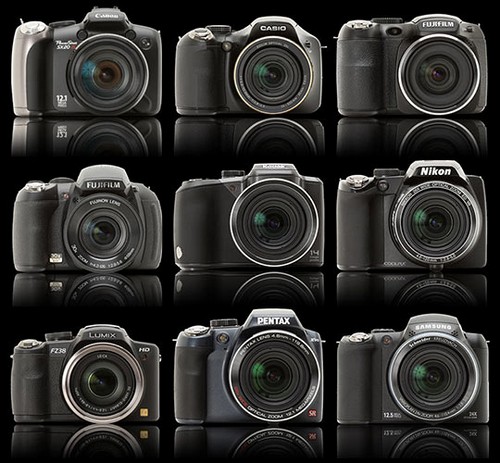
There are perhaps still many of us that still don’t know the basic difference between the three types of cameras. But much of the masses usually choose the simple point-and-shoot pocket cameras over the rest, and it’s usually the right choice. Just point then shoot, it can’t get any simpler than that!
So when do you need a prosumer or a DSLR camera? Or you may also wonder: Is it better to purchase a DSLR or a prosumer camera? Or is a basic pocket camera enough?
The answer is really up to you. It all depends on your photography needs. But before you make your final decision on which to purchase, it’s best you know the basic difference between these three. The following are comparisons between the three; and I will discuss subjects surrounding the physical exteriors, features, sensors, lenses, and functionality.

1. Pocket Point-and-Shoot Cameras
Exterior Body:
The forms of pocket cameras are typically thin and rather tiny, easy to store in your pockets or anywhere else. Many are tempted by its charming and elegant designs. It’s simple. Not restrictive from any particular group, this type of camera is definitely the camera most people own.
Features:
Its use is very easy. With a very much automatic system, users only need to view the target using the viewfinder and press the shutter button to record a photograph. This simplicity of use is evidently one of the main reasons why many of us choose this type over the others. Unfortunately, the features of the point-and-shoots don’t allow us to manually set the values of its features. This is no doubt the main weakness of a pocket camera.
Sensors:
Sensors on digital cameras function as the picture recorder. And it’s for certain that sensors in pocket cameras are smaller than those on Prosumers and DSLRs. And it’s intentionally designed so, because pocket cameras do not need big sensors. But consequently, the area recorded will be cropped. The results will be different to that of a DSLR; having a bigger sensor means a wider recorded area.
Lenses:
Lenses provided in a pocket camera are usually quite wide. The optical zoom is also acceptable for a pocket camera. But of course the lens isn’t interchangeable like how it’s possible on a DSLR. And I really don’t think a pocket camera needs an interchangeable lens because these pocket cameras are usually aimed for consumers with little knowledge of the world of photography; consumers that don’t need the creativity of creating an artistic photograph.
Functionality:
If you look at the capabilities and convenience offered by a pocket camera, it’s evident that the intended user is a user who only wants ease in the use of a camera. It’s suitable for documenting office or family events. It’s quite reliable as a tool to record moments that doesn’t require a high level of creative artistic photographs. But it’s also acceptable for use by a novice photography student. All you have to do is push one button, and voila!
So go ahead and purchase a point-and-shoot pocket camera if your main use of a camera is to document events. But you must also note that the price for a new pocket camera is almost the same as that of a used DLSR (Semipro). It’s best if you browse and research prices and features offered.

2. Prosumer Cameras
Exterior Body:
The form resembles a DLSR, a bit bulky. It’s a bit difficult to distinguish by comparing the bodies. Made to look like a DSLR because it’s main purpose is to be an alternative for consumers wanting to purchase a DSLR but doesn’t have the funds for it. The ergonomic exterior body is designed to fit the user when holding the camera. And the body is made to accommodate its lens; which are greater in dimension and weight than those installed on pocket cameras. Generally, the lenses on prosumers are the size as lenses made for DSLR cameras.
Feature:
Resembles a DSLR. The program settings can be toggled manually. The aperture, ISO, and shutter speed can be set manually. This means that our creativity won’t be limited by an automated system. And what’s even more alluring, almost all Prosumers these days have the ability to record video and has a Live View feature – features that will cost you in DSLR cameras. And also in several Prosumers, the object seen on the viewfinders doesn’t directly come from the lens (not TTL), but through the camera sensor. So what you see through the viewfinder is a tiny LCD showcasing the object.
Sensor:
Sensors used in Prosumer cameras are usually bigger than that in pocket cameras, but still smaller than those in DLSRs. This is one of the basic differences between a prosumer and a DSLR camera. This is closely related to the sensor’s ability in capturing bokeh (blur) and the crop factor (the amount of cropping a sensor does to a photograph) produced by the Prosumer camera.
Lens:
Still unlike the DSLR, the prosumer camera’s lens aren’t interchangeable. This is the biggest difference between a prosumer and a DSLR. But the focal length on a prosumer lens is usually an all-in-one, with a wide aperture; quite alluring for a lens. Not to mention if the attached lens is a Carl-Zeiss or other well-known lens brands. Oftentimes people say that you’re really purchasing a lens, with a camera as a bonus. Why so? Go ahead and look for an 18-300/2.8 lens, it’s sure to be quite pricey, and even more so if it’s a Carl-Zeiss brand lens. The trade-off is quite fantastic, right?
Functionality:
Prosumer cameras are intended for consumers that want to explore the world of photography, by offering features similar to DSLRs while also equipped with a competent lens. More compact than the DSLR, you wouldn’t need to bring along bulky gear. All you need is this one camera, without needing to carry extra lenses (because it really cannot be replaced). Just remember that the sensors of Prosumer cameras are smaller than DSLR and the lenses can’t be replaced as you wish.

3. DSLR Cameras
Exterior Body:
Big and bulky body, made ergonomically to suit the user’s grip, and generally similar to the Prosumer camera. And one thing’s for sure, you can’t put these cameras in your pocket. Has a comfortable handgrip, especially useful for when in use with a heavy lens.
Features:
The settings are of course able to be set manually. Aperture, ISO, and shutter speed can be set at will. All DSLRs have these as the basic features. It’s these settings that allow us to control the camera settings in order to achieve photographs that fit our own artistic style (besides the type of lens we use, of course).
The difference in features often discussed when comparing one DSLR from another is the Live View and Video Recording capabilities. These features have a different mechanism than those found in Pocket and Prosumer cameras, making the availability of these features in a DSLR hike up the price of said DSLR. Many think that it’s more worth it to allocate their cash towards purchasing different lenses than purchasing a high-end DSLR.
Sensors:
A DSLR’s sensor is larger than that of a Pocket or Prosumer camera, making shooting a photograph with a DSLR wider in view than using the other two types. The size of the sensor is directly proportional to the cost of production, so it’s no wonder that DSLRs are generally more expensive than Prosumer and Pocket cameras. The sensor technology on a DSLR is usually low in noise. Hence the photographs produced are relatively cleaner when it comes to pixels that would usually produce color anomalies /noise (most apparent when shooting in low-light settings).
Lenses:
When discussing DSLR, one can’t be far from the subject of lenses because one of the advantages of a DSLR is its interchangeable lenses that comes in different types. Many photography enthusiasts collect these different types of lenses, because the different types have a variety of uses. Here, besides toggling the camera settings, you can experiment and try to produce different types of photograph.
If you’re not careful, collecting lenses may become an addiction. And such an addiction will surely quickly thin out your wallet.
Functionality:
The DSLR is highly suitable for consumers/users that wants to further explore the world of photography and all that it has to offer. Of course here you’ll have to learn the techniques. DSLR is but a mere canvas and brush that needs your creativity to produce something beautiful. Purchasing a DSLR does not guarantee you a great photograph. For that, you need to learn the techniques. And luckily, living in a digital world, it’s now so much easier to learn than back in the analogue days using SLR (film) cameras. There are also plenty of resources like this one available on the Internet for you to learn from. Browse my website to learn more about the art and techniques of photography!
Please note thought that DSLRs are a complicated apparatus (if not used to it). There are many extra gears and accessories that you will need down the line.
Conclusion:
Of these three types of camera, the best choice can be made when you examine the purpose of the purchase. I can conclude that:
1. Pocket Cameras: Great for mere documentations of various events with no fuss.
2. Prosumer Cameras: Great for starting out in learning about photography without the need to interchange the lens.
3. DSLR Cameras: Great for further exploring what the world of photography has to offer. For those that love to experiment and would like to be serious about photography.
So list the main things you’ll be using your camera for, and compare it to this article. You’ll surely get one that best suits you!
Recommended Product:




